Recent Posts
Revitalize Your Home with Spring Cleaning in Bountiful, UT: Let SERVPRO Lead the Way
4/8/2024 (Permalink)
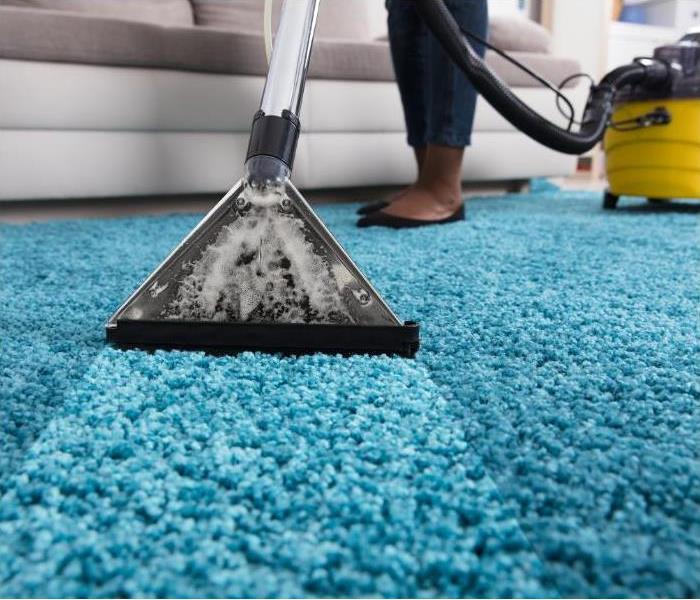 Spring Cleaning in Bountiful, UT
Spring Cleaning in Bountiful, UT
As the chill of winter fades away and the warmth of spring begins to bloom, it's time to shake off the dust of hibernation and embrace the revitalizing spirit of the season. And what better way to do so than by indulging in the age-old tradition of spring cleaning? In Bountiful, UT, where the majestic beauty of the Wasatch Range meets the serenity of the Great Salt Lake, there's no better time to breathe new life into your home than during the vibrant days of spring. And when it comes to tackling the monumental task of spring cleaning, there's one name that stands out above the rest: SERVPRO.
Embracing the Essence of Spring Cleaning
Spring cleaning isn't just about tidying up your living space; it's about embracing a fresh start, rejuvenating your surroundings, and revitalizing your spirit. In Bountiful, where the beauty of nature is a constant inspiration, spring cleaning takes on an added significance. It's a time to shake off the cobwebs, clear out the clutter, and prepare your home for the sunny days and warm nights ahead.
But let's face it: spring cleaning can be a daunting endeavor. From dusting high shelves to scrubbing stubborn stains, from organizing cluttered closets to deep cleaning carpets, the list of tasks can seem never-ending. That's where SERVPRO comes in.
Why Choose SERVPRO for Your Spring Cleaning Needs?
With a reputation for excellence and a commitment to customer satisfaction, SERVPRO is your trusted partner in the quest for a cleaner, healthier home. Here's why homeowners in Bountiful, UT, turn to SERVPRO time and time again:
Expertise: SERVPRO's team of highly trained professionals possesses the knowledge, skills, and experience to tackle even the toughest cleaning challenges. From specialized equipment to proven techniques, they have everything needed to leave your home sparkling from top to bottom.
Comprehensive Services: Whether you need a thorough carpet cleaning, a meticulous tile and grout scrubbing, or a complete overhaul of your HVAC system, SERVPRO has you covered. Their comprehensive range of services ensures that no corner of your home goes untouched.
Advanced Technology: SERVPRO stays at the forefront of industry advancements, utilizing state-of-the-art equipment and cutting-edge technology to deliver superior results. From powerful extraction machines to eco-friendly cleaning solutions, they employ the best tools available to achieve optimal cleanliness with minimal environmental impact.
Customized Solutions: Every home is unique, which is why SERVPRO takes a personalized approach to spring cleaning. Their team works closely with each client to assess their specific needs and develop a customized cleaning plan tailored to achieve the desired results.
Commitment to Excellence: Above all, SERVPRO is committed to excellence in everything they do. From the moment you contact them to the completion of the job, you can expect nothing less than the highest level of professionalism, integrity, and quality craftsmanship.
Spring Cleaning Services Offered by SERVPRO
So, what exactly can SERVPRO do to help you refresh and revitalize your home this spring? Here's a glimpse of their comprehensive range of services:
Carpet Cleaning: Say goodbye to ground-in dirt, stubborn stains, and lingering odors with SERVPRO's professional carpet cleaning services. Using advanced equipment and environmentally friendly cleaning solutions, they'll leave your carpets looking and feeling like new.
Tile and Grout Cleaning: Restore the beauty of your tiled surfaces with SERVPRO's thorough tile and grout cleaning services. Their specialized techniques penetrate deep into the grout lines to remove dirt, grime, and mildew, leaving your floors sparkling clean and sanitized.
Upholstery Cleaning: Give your furniture a fresh lease on life with SERVPRO's upholstery cleaning services. Whether it's a beloved sofa, a cherished armchair, or a vintage loveseat, their experts will carefully clean and protect your upholstery, ensuring years of comfort and enjoyment.
Air Duct Cleaning: Improve indoor air quality and enhance HVAC system efficiency with SERVPRO's professional air duct cleaning services. By removing dust, debris, and allergens from your ductwork, they'll help you breathe easier and enjoy a healthier home environment.
Odor Removal: Banish unpleasant odors once and for all with SERVPRO's advanced odor removal techniques. Whether it's smoke, pet odors, or musty smells, their experts will identify the source of the odor and eliminate it at its root, leaving your home smelling fresh and clean.
Experience the Difference of SERVPRO Spring Cleaning
This spring, why settle for anything less than the best when it comes to refreshing and revitalizing your home? Experience the difference of SERVPRO spring cleaning and discover why homeowners in Bountiful, UT, trust them to deliver exceptional results time and time again. Say goodbye to the dust and grime of winter and hello to a cleaner, healthier home with SERVPRO by your side.
How to Identify a Mold Problem in Your Bountiful, UT Home
3/11/2024 (Permalink)
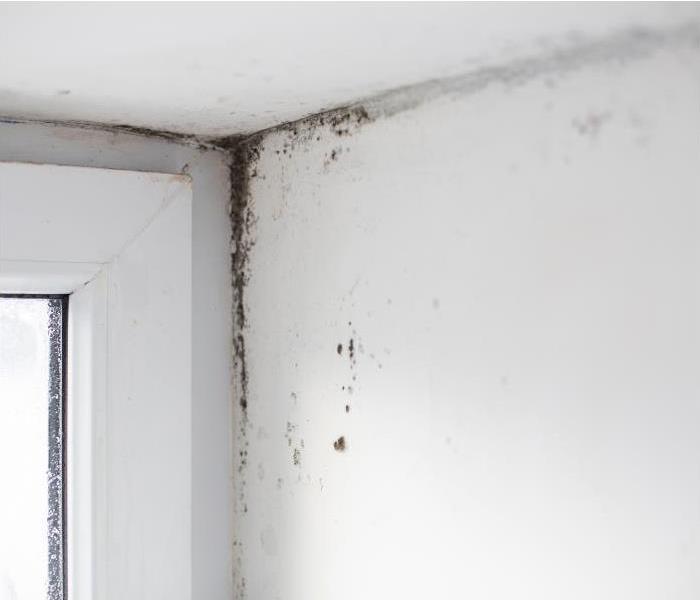 Mold problems in Bountiful, Ut
Mold problems in Bountiful, Ut
Living in the picturesque city of Bountiful, UT, surrounded by stunning landscapes and a thriving community, is a dream for many. However, even in this idyllic setting, homeowners may encounter challenges like mold growth. Mold is a common issue that can affect homes, posing potential health risks and structural concerns. In this blog, we will explore the ways to identify a mold problem in your Bountiful home and discuss the importance of prompt action.
Understanding Mold:
Before diving into the signs of a mold problem, it's essential to understand what mold is and why it can be a concern. Mold is a type of fungus that thrives in damp and humid environments. It reproduces through tiny spores that are invisible to the naked eye, making it difficult to detect in its early stages. Mold can grow on various surfaces, including walls, ceilings, floors, and even hidden spaces like crawl spaces and attics.
Signs of a Mold Problem:
Musty Odor:
One of the earliest indicators of a potential mold issue is a musty or earthy smell in your home. Mold releases volatile organic compounds (VOCs) that contribute to this distinct odor. If you notice a persistent musty smell, it's crucial to investigate further, as it could be a sign of hidden mold growth.
Visible Mold Growth:
Mold often appears as discolored patches on surfaces. It can be black, green, brown, or white, depending on the type of mold. Check areas prone to moisture, such as bathrooms, kitchens, and basements, for any visible signs of mold growth. Pay attention to walls, ceilings, and corners where moisture might accumulate.
Water Leaks or Moisture Issues:
Mold requires moisture to thrive. Therefore, water leaks or excessive moisture in your home can create an ideal environment for mold growth. Regularly inspect your home for leaks, especially around plumbing fixtures, roofs, and windows. Addressing water issues promptly can prevent mold from taking hold.
Peeling or Discolored Paint:
Mold can cause paint to peel or discolor. If you notice unusual changes in the appearance of painted surfaces, it may be a sign of mold growth beneath the paint. Investigate the affected areas to determine the source of the issue.
Condensation:
Excessive condensation on windows, walls, or pipes can create a conducive environment for mold. Inspect areas prone to condensation regularly, especially during colder months, and take steps to improve ventilation and reduce humidity levels.
Importance of Addressing Mold Promptly:
Identifying and addressing a mold problem promptly is crucial for several reasons:
Property Damage:
Mold can damage the structural integrity of your home. It can weaken walls, ceilings, and other surfaces, leading to costly repairs. Timely intervention can prevent extensive damage and preserve the structural integrity of your home.
Preventing Spread:
Mold can spread rapidly if left unchecked. Taking prompt action to address the issue can prevent the spread of mold to other areas of your home, minimizing the scope of remediation and reducing associated costs.
Living in Bountiful, UT, offers a unique blend of natural beauty and community spirit. However, even in this charming city, homeowners may encounter mold problems. By staying vigilant for signs of mold, addressing water issues promptly, and taking immediate action when mold is detected. If you suspect a mold problem, it's advisable to consult with professionals experienced in mold remediation to ensure a thorough and effective resolution. Remember, early detection and proactive measures are key to maintaining a mold-free home in Bountiful.
Unveiling Hidden Toilet Leaks and SERVPRO of Bountiful’s Restoration Expertise
1/15/2024 (Permalink)
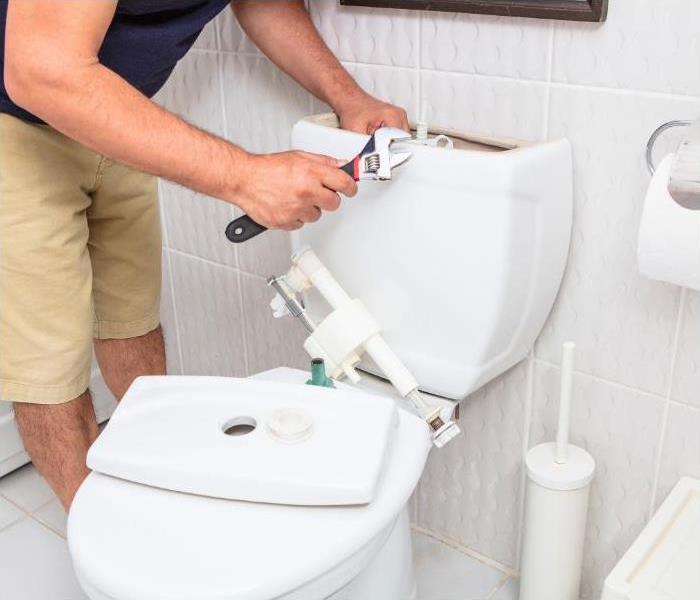 Leaking toilet in Bountiful, UT
Leaking toilet in Bountiful, UT
Your home is your sanctuary, a place of comfort and security. However, even in the most well-maintained homes, unforeseen issues like hidden toilet leaks can wreak havoc and compromise the integrity of your living space. Water damage is a silent menace, often originating from inconspicuous sources like leaking toilets, and if left unaddressed, it can lead to structural damage, mold growth, and other costly problems. In times of crisis, it's essential to have a reliable partner like SERVPRO of Bountiful to help restore your home and peace of mind.
Detecting Hidden Toilet Leaks:
Identifying a hidden toilet leak early is crucial to preventing extensive water damage. Here are some signs that might indicate a leak:
Unexplained Increase in Water Bills:
Keep a close eye on your water bills. A sudden, unexplained increase could be a sign of a concealed water leak.
Musty Odors:
Mold and mildew thrive in damp environments. If you notice a musty smell in your bathroom or surrounding areas, it may indicate hidden water damage.
Stained or Peeling Paint:
Water leaks can damage walls, causing paint to peel or stain. Inspect the walls near your toilet for any unusual discoloration.
Soft or Warped Flooring:
Constant exposure to moisture can compromise the integrity of your flooring. If you notice soft or warped areas, investigate for potential leaks.
Visible Mold Growth:
Mold can grow rapidly in damp conditions. Check for any visible signs of mold on walls, ceilings, or around the toilet area.
Dealing with Water Damage:
Once a hidden toilet leak is detected, taking immediate action is vital to prevent further damage. Here's a step-by-step guide on how to deal with water damage:
Turn off the Water Supply:
Shut off the water supply to the toilet to prevent further leakage. This is typically done by turning the shut-off valve located behind or beneath the toilet.
Assess the Extent of Damage:
Evaluate the severity of the water damage. Check for standing water, saturated materials, and potential areas where moisture might have spread.
Remove Excess Water:
Use towels, a wet/dry vacuum, or a mop to remove standing water. The sooner you can extract the water, the better chance you have of preventing secondary damage.
Ventilate the Area:
Increase ventilation to help dry out the affected area. Open windows, use fans, and consider using a dehumidifier to reduce humidity levels.
Inspect for Mold:
Mold can start growing within 24-48 hours of water exposure. Thoroughly inspect the affected area for mold growth. If found, take appropriate precautions and consider professional mold remediation.
Contact SERVPRO of Bountiful:
When water damage is extensive or if you're unsure about the restoration process, it's crucial to seek professional help. SERVPRO of Bountiful specializes in water damage restoration and has the expertise and equipment to handle even the most challenging situations.
SERVPRO of Bountiful's Restoration Expertise:
Why choose SERVPRO of Bountiful for water damage restoration? Here are some compelling reasons:
24/7 Emergency Response:
Water damage doesn't wait for a convenient time, and neither do we. SERVPRO of Bountiful offers round-the-clock emergency response, ensuring that help is just a phone call away.
Advanced Equipment and Techniques:
SERVPRO technicians are equipped with state-of-the-art tools and technology to efficiently mitigate water damage. This includes moisture meters, industrial-strength air movers, and dehumidifiers.
IICRC-Certified Professionals:
Our technicians are certified by the Institute of Inspection, Cleaning and Restoration Certification (IICRC), ensuring that they are well-trained and knowledgeable in the latest restoration techniques.
Comprehensive Restoration Services:
SERVPRO of Bountiful provides a full spectrum of restoration services, from water extraction and drying to mold remediation and structural repairs. We aim to restore your home to its pre-damage condition.
Insurance Coordination:
Dealing with insurance claims can be overwhelming. SERVPRO of Bountiful works closely with insurance companies to streamline the claims process and alleviate the burden on homeowners.
A hidden toilet leak may seem like a minor inconvenience, but the potential consequences can be severe. Swift action is key to minimizing damage and restoring your home to its former glory. By partnering with professionals like SERVPRO of Bountiful, you can trust that your home is in capable hands. Don't let water damage disrupt your peace of mind—act promptly, and let the experts guide you through the restoration process. Your home deserves the best care, and SERVPRO of Bountiful is here to deliver just that."
Mastering the Art of Winter Home Maintenance: A Guide to Preventing and Dealing with Frozen Pipes
12/28/2023 (Permalink)
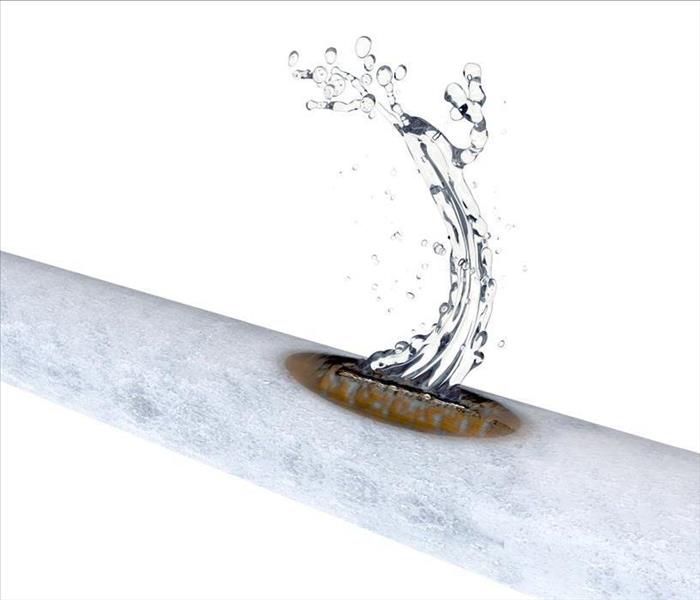 A frozen pipe in Bountiful, UT.
A frozen pipe in Bountiful, UT.
As winter descends upon the charming city of Bountiful, Utah, homeowners brace themselves for the challenges that come with plummeting temperatures. One of the most common and potentially damaging issues during the winter months is the freezing of pipes. In this comprehensive guide, we will delve into the proactive measures you can take to prevent frozen pipes and offer expert advice on thawing them if the need arises. Embrace the winter wonderland while safeguarding your home with these essential tips.
Understanding the Threat:
Why Do Pipes Freeze?
Before we delve into prevention strategies, it's essential to understand why pipes freeze in the first place. When temperatures drop, especially during cold snaps common in Bountiful, the water inside pipes can freeze, leading to expansion. This expansion creates pressure within the pipes, and if it becomes too intense, it can cause them to burst. Burst pipes can result in water damage, structural issues, and costly repairs. Now, let's explore practical steps to prevent this winter woe.
6 Steps To Prevent Frozen Pipes
1. Invest in Comprehensive Insulation: Shielding Your Pipes from the Cold
As the first line of defense, insulation plays a pivotal role in protecting your pipes from the harsh winter chill. Conduct a thorough inspection of your home, paying close attention to areas where pipes are exposed, such as attics, basements, and crawl spaces. Wrap pipes with pipe sleeves, use heat tape, or apply foam insulation to create a barrier against the cold. Remember, the investment in quality insulation can pay off in the long run by preventing potential damage and reducing energy costs.
2. Embrace the Drip: Allowing Faucets to Flow
On exceptionally cold nights, consider letting faucets connected to vulnerable pipes drip slowly. This continuous flow of water disrupts the formation of ice within the pipes, lowering the risk of freezing. While this may lead to a minor increase in water usage, it's a small price to pay compared to the potential damage caused by frozen and burst pipes.
3. Seal the Gaps: Locking Out the Cold
Leaks and gaps in your home's structure can allow cold air to infiltrate, putting your pipes at risk of freezing. Conduct a thorough inspection of your home's exterior, including windows, doors, and the foundation. Seal any cracks or gaps using caulk or weatherstripping to fortify your home against the winter chill. By maintaining a tight envelope, you create a warmer environment for your plumbing system.
4. Strategic Use of Space Heaters: Targeting Trouble Spots
Strategically placing space heaters in key areas of your home can be an effective preventive measure. Focus on spaces where pipes are most vulnerable, such as basements, attics, and crawl spaces. However, it's crucial to use space heaters safely and responsibly, following manufacturer guidelines and never leaving them unattended. When used correctly, these heaters can provide an extra layer of warmth to protect your pipes from freezing temperatures.
5. Open Cabinet Doors: Enhancing Airflow in Enclosed Spaces
For pipes located beneath sinks, especially in kitchens and bathrooms, leaving cabinet doors open during colder nights can promote better airflow. This allows warmer air to circulate around the pipes, reducing the likelihood of freezing. For additional airflow enhancement, consider using a small fan in enclosed spaces to maintain a consistent and warmer temperature.
6. Thawing Frozen Pipes: A Gentle Approach is Key
In the unfortunate event that you discover frozen pipes, it's essential to thaw them gently to avoid causing further damage. Never resort to excessive heat or open flames, as this can lead to burst pipes. Instead, use a hairdryer, heating pad, or towels soaked in hot water to apply gentle heat to the affected area. Start at the faucet and work your way towards the blockage, exercising patience throughout the process. This careful approach helps prevent potential water damage and preserves the integrity of your plumbing system.
Winterizing Your Home for a Stress-Free Season
As winter settles in Bountiful, Utah, and the landscape transforms into a snowy wonderland, your home should be a warm and secure haven. By implementing these comprehensive strategies, you not only shield your pipes from the threat of freezing but also ensure a comfortable and stress-free winter for you and your family. From insulation and strategic heating to proactive measures like letting faucets drip, mastering the art of winter home maintenance is the key to a worry-free season. Embrace the beauty of winter while safeguarding your home—because with the right precautions, you can enjoy the magic of the season without the fear of frozen pipes. Stay warm, stay prepared, and let your home be a sanctuary in the midst of winter's embrace.
A Comprehensive Guide to Prepare and Protect Your Home
12/2/2023 (Permalink)
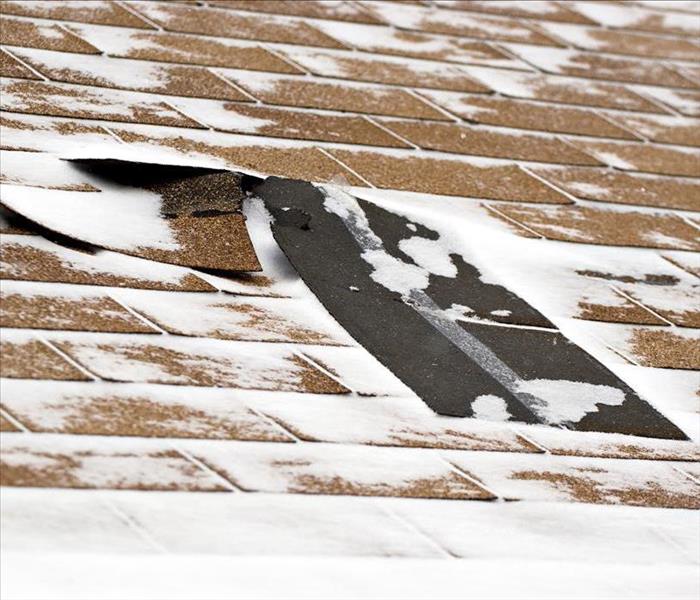 Roof damage in Bountiful, UT due to snow storm.
Roof damage in Bountiful, UT due to snow storm.
As the air turns crisp and the first snowflakes begin to fall, residents of Bountiful, Utah, know that winter is just around the corner. While the snowy landscapes can be picturesque, the winter season also brings its fair share of challenges, especially for homeowners. From freezing temperatures to heavy snowfall, preparing your home for winter is crucial to avoid damage and ensure a cozy and safe living environment. In this comprehensive guide, we'll explore the essential steps to fortify your home against the harsh winter elements in Bountiful.
10 Tips to Prepare and Protect Your Home
1. Inspect and Reinforce Your Roof:
The first line of defense against winter's fury is your roof. Perform a thorough inspection to identify any missing or damaged shingles, as well as leaks. Addressing these issues promptly can prevent water damage during heavy snowfall. Additionally, consider reinforcing your roof with ice and water shield membrane, especially in areas prone to ice dams. This extra layer provides an added barrier against melting snow and ice, safeguarding your home from potential leaks.
2. Clean and Insulate Gutters:
Clogged gutters can lead to ice dams, a common issue in colder climates like Bountiful. Before winter sets in, clean out your gutters and downspouts to ensure proper water drainage. Install gutter guards to prevent debris buildup and consider adding insulation to your attic to regulate temperature and minimize the risk of ice dams forming along the roofline.
3. Protect Pipes from Freezing:
Utah's winters can be bitterly cold, and frozen pipes are a significant concern. Insulate exposed pipes in unheated areas of your home, such as the attic or crawl spaces, to prevent freezing. Consider using heat tape for added protection, and make sure to disconnect and drain outdoor hoses. In extreme cold, leave faucets dripping to keep water flowing and minimize the risk of pipes bursting.
4. Service Your Heating System:
A well-functioning heating system is essential for a comfortable and warm winter. Schedule a professional inspection and maintenance for your furnace or heating system before the temperatures plummet. Change air filters regularly, and if you have a fireplace or wood-burning stove, have the chimney cleaned and inspected to ensure safe operation.
5. Seal Drafts and Insulate Windows:
Drafts around windows and doors can significantly impact your home's energy efficiency. Inspect for gaps and use weatherstripping or caulk to seal any leaks. Consider investing in thermal curtains or adding window insulation film to keep the cold air out and the warm air in. These simple steps not only improve comfort but also reduce heating costs during the winter months.
6. Stock Up on Winter Supplies:
Bountiful's winter storms can sometimes lead to power outages and road closures. Be prepared by stocking up on essential supplies. Create an emergency kit that includes non-perishable food, water, blankets, flashlights, and batteries. Keep a supply of rock salt or ice melt to prevent slips and falls on icy surfaces. Having these items readily available ensures you're prepared for unexpected winter challenges.
7. Winterize Your Landscaping:
Prepare your outdoor spaces for the winter by trimming tree branches that could pose a threat during heavy snowfall. Clear away debris from your yard, as snow accumulation on top of leaves and branches can cause damage. Consider wrapping young or delicate trees with burlap to protect them from freezing temperatures and winter winds.
8. Check Your Home's Insulation:
A well-insulated home is key to maintaining a consistent and comfortable indoor temperature. Inspect your home's insulation, focusing on the attic and walls. If needed, add extra insulation to improve energy efficiency and keep your home warm. This not only enhances comfort but also reduces heating costs in the long run.
9. Prepare for Snow Removal:
Utah winters bring ample snowfall, and being prepared for snow removal is crucial. Ensure your snow blower or shovel is in good working condition. Stock up on ice melt or sand to keep driveways and walkways safe. Consider hiring a professional snow removal service if needed, especially for larger properties.
10. Review Home Insurance Coverage:
Finally, take the time to review your home insurance coverage. Ensure it adequately protects against winter-related damages such as burst pipes, roof collapses, or other weather-related incidents. Understanding your policy and making any necessary adjustments will provide peace of mind during the winter months.
As winter blankets Bountiful, Utah, in a layer of snow, taking proactive steps to prepare your home is essential. From fortifying your roof to insulating pipes and ensuring a reliable heating system, these measures not only protect your home from potential damage but also create a warm and welcoming haven during the coldest months of the year. By following this comprehensive guide, you'll be well-equipped to face the challenges of winter, ensuring a safe and enjoyable season for you and your loved ones.
Protecting Your Home from Fire Hazards and Restoring Your Peace of Mind with SERVPRO of Bountiful
10/23/2023 (Permalink)
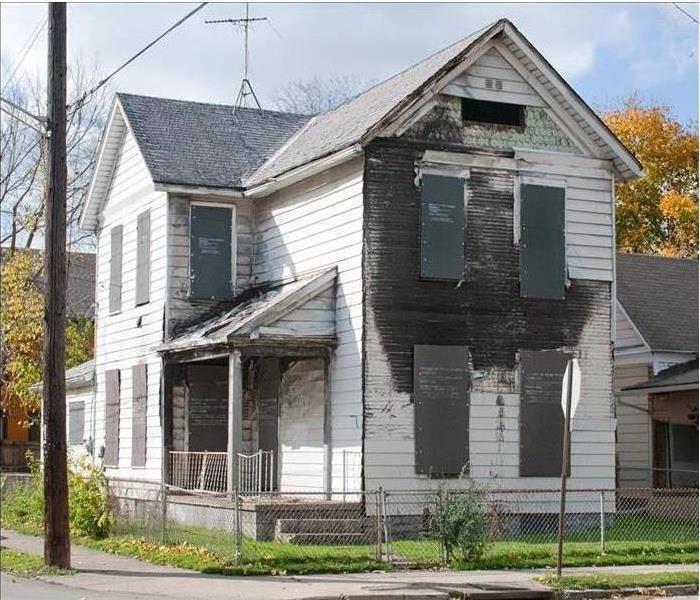 Fire damaged home in Bountiful, Utah.
Fire damaged home in Bountiful, Utah.
The safety and security of our homes are among our top priorities. Fire hazards can pose a significant threat to our cherished abodes, and understanding the leading causes of home fires is the first step in prevention. In this blog post, we'll delve into the primary causes of home fires and explore how SERVPRO of Bountiful can help you restore your home and peace of mind if you ever find yourself facing a fire-related disaster.
Understanding the Leading Causes of Home Fires
Electrical Fires: Electrical fires are one of the most common causes of residential fires. They can be triggered by faulty wiring, overloaded circuits, or malfunctioning electrical appliances. To prevent electrical fires, it's crucial to have your electrical systems inspected regularly and perform necessary maintenance. Flickering lights, charred outlets, or a burning odor are all signs that your electrical system may be at risk. Be vigilant and proactive to avoid these hazards.
Cooking Accidents: Unattended stovetops, hot oil, and grease fires are often responsible for kitchen-related fires. Cooking is a daily activity, and the risk of a fire is ever-present. Vigilance is key to prevention. Always keep an eye on the stove, use timers if necessary, and never leave the kitchen while cooking. Ensure that flammable materials are stored away from heat sources. Small measures like these can go a long way in preventing kitchen fires.
Heating Equipment: Heating equipment, including space heaters, fireplaces, and furnaces, can pose a fire hazard if not properly maintained. Have your heating appliances serviced regularly and ensure that they are free from any defects. Keep flammable materials away from heat sources, and use safety screens for fireplaces. These precautions can significantly reduce the risk of heating equipment-related fires.
Smoking: Cigarettes and candles can also lead to devastating fires. Smoking should be done outdoors, and proper ashtrays should be used. For candles, always place them in secure holders and keep them away from flammable materials. Educate children about the dangers of fire and the importance of fire safety. Simple safety practices can prevent these types of fires from occurring.
Faulty Wiring: Faulty wiring in your home can lead to electrical fires. Older homes are particularly susceptible to this hazard. Regular inspections by professional electricians are crucial in identifying and addressing potential issues. Investing in the maintenance and upgrading of your home's wiring can significantly reduce the risk of electrical fires.
Children and Matches: Curious children may find and play with matches or lighters, inadvertently starting fires. It's essential to educate your children about fire safety and keep matches and lighters out of their reach. Store these items securely in a location inaccessible to young hands. Simple safety measures can prevent fire-related accidents involving children.
Flammable Chemicals: Improper storage of flammable chemicals and fuels can lead to explosive fires. Always store these items in a safe and designated location, away from heat sources and open flames. Follow safety guidelines for handling and storing such chemicals, and make sure your family is aware of the potential risks.
Restoring Your Home with SERVPRO of Bountiful
Preventing home fires is of paramount importance, but accidents can still happen. In the unfortunate event of a fire, we are here to help you restore your home and your peace of mind. Our team of professionals is well-equipped to handle the aftermath of a fire, providing expert services that include:
1. Fire Damage Assessment: Our experts will assess the extent of the fire damage, including structural damage and damage to your belongings. This initial assessment is crucial in planning the restoration process.
2. Smoke and Soot Cleanup: Smoke and soot residues can linger long after the fire is extinguished. Our team uses advanced cleaning techniques and equipment to remove these residues from your home's surfaces, making it safe and habitable once more.
3. Content Cleaning: Our content cleaning services will help restore your personal belongings, from clothing and furniture to electronics and family heirlooms. We employ various methods to clean and deodorize your possessions, minimizing the impact of the fire.
4. Structural Repairs: Fire can cause extensive damage to your home's structure. SERVPRO of Bountiful has the expertise to repair and restore your home, from minor repairs to major reconstruction if needed. Our goal is to return your home to its pre-fire condition.
5. Odor Removal: Lingering smoke odors can be a constant reminder of the fire. Our team employs specialized equipment and techniques to eliminate these odors, ensuring your home smells fresh and clean once again.
6. Insurance Assistance: Dealing with insurance companies can be a challenging aspect of post-fire recovery. We can work directly with your insurance provider to facilitate a smoother claims process.
7. 24/7 Emergency Response: Fires don't adhere to a schedule, which is why our team is available 24/7 to respond to your emergency. We understand the urgency of the situation and are dedicated to helping you in your time of need.
Preventing home fires is essential, but it's also crucial to be prepared for the unexpected. In the event of a fire-related disaster, SERVPRO of Bountiful is your trusted partner in restoring your home and peace of mind. Our team of professionals is committed to providing comprehensive fire damagerestoration services in Bountiful, UT, helping you get your life back on track. Don't let a home fire define your future; trust SERVPRO of Bountiful to help you reclaim your sense of safety and security by restoring your cherished home. Together, we can make your house a home once more.
How Do I Stop a Toilet That Won’t Stop Flushing?
9/13/2023 (Permalink)
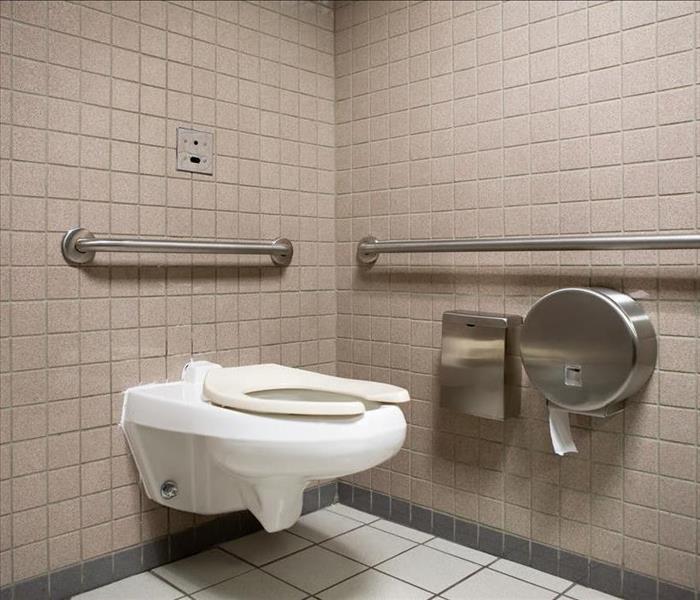 Avoid a toilet flood in Bountiful, UT.
Avoid a toilet flood in Bountiful, UT.
Running a business in Bountiful, UT, comes with various responsibilities, some of which can be quite an annoyance. A toilet overflow is terrible enough, but what about a commercial toilet with a faulty flushometer? As easy as they usually make life, like anything, things can sometimes go wrong with a flushometer. One common problem is the "never-ending flush," when the flushometer constantly runs water into the toilet with no sign of stopping. This can quickly waste hundreds of gallons of water and run your company's water bill through the roof. It can also take your only toilet out of commission for your employees and customers. Fortunately, it can often be an easy fix, so you probably won't have to worry about calling a plumber.
Fix a Faulty Flushometer To Avoid a Toilet Flood
These instructions are for repairing a manual flushometer. Taking these simple steps should solve your problem.
- Shut Off the Water
First, you must shut off the toilet's water supply. You will typically need a flathead screwdriver for this job. You should see a screwdriver slot on one side of the flushometer. If you don't see a screwdriver slot, it may be hidden under a decorative cover. In this case, you should be able to pry the lid off with little effort to access the screwdriver slot. This will help avoid a leak while you work, particularly with a constantly running toilet.
- Remove the Flushometer Lid
Next, you will need to remove the top lid of the flushometer. You will probably need a wrench to loosen the cover, but it should screw off with ease once it's loosened.
- Remove the Flange Cover
You will now need to remove the flange cover. This can sometimes get a little messy with the accumulation of water that will come out when you take the lid off. Be sure to have a towel on hand.
- Remove and Clean the Gasket
Under the flange cover, you will find a gasket. You will also probably notice a lot of sediment on the gasket. Remove the gasket and wash it thoroughly. Look closely, and you will see a weep hole built into the gasket. Although tiny, this hole is there for a reason and could be the main issue with your flushometer's poor performance; the weep hole helps control the suction of the toilet. To help avoid a toilet overflow, you'll need to clean the weep hole port with an unbent paperclip, needle, or some other object that is very small in width.
- Reinstall the Gasket and Reassemble the Flushometer
Now that your gasket is clean reinstall it and reassemble the flushometer. Just go in the reverse order of the above instructions to ensure it's assembled correctly.
- Test the Operation of the Toilet
Once the flushometer is put back together, test the toilet to see if the problem has been solved. If it is still not working correctly, it probably means the gasket is worn or damaged and needs replacement.
Sometimes you can't stop a toilet in time to keep it from overflowing. When this happens, it's nice to have the contact information for local water damage restoration specialists. After a toilet overflow, these professionals will ensure the affected area is thoroughly cleaned and sanitized.
4 Steps To Extinguish a Kitchen Grease Fire
8/31/2023 (Permalink)
 Even the smallest flame can destroy your house in Bountiful, UT if the fire is not controlled on time.
Even the smallest flame can destroy your house in Bountiful, UT if the fire is not controlled on time.
Did you know that nearly two-thirds of household fires start in the kitchen, and the majority of those are caused by a grease fire? If a homeowner is not careful, a small, manageable fire can become a significant disaster.
How to put out a Grease Fire
Unfortunately, the majority of homeowners do not know how to put out simple grease fires. In fact, many homeowners will take actions that put themselves and their families at risk, like attempting to put the fire out with water or trying to move the pan or pot outside. If you want to avoid a significant fire cleanup, fire mitigation services in Bountiful, UT, recommend taking four steps to resolve a grease fire.
- Cover the flames
- Turn off the heat
- Use baking soda or salt
- Use a Class B dry chemical fire extinguisher
Control the Flames
When a fire starts, it can be shocking. If you do not have a lot of experience around flames, you might freeze as your brain tries to process what to do.
The best thing you can do when a cooking source ignites is cover it with a non-flammable item. For the best results, use a cookie sheet or metal pan lid. You’ll want to leave the cover on until the area has cooled.
The idea is to smother or deprive the flames of oxygen. Covering the pan is the quickest way to do that.
Eliminate the Heat Source
After covering the pan, you’ll want to eliminate the heat source. Many people make the mistake of taking the pan off of the stove. Do not move the pan. Moving a pan filled with grease risks spreading the fire. Instead of moving the pan, simply turn off the burner.
If you have an electric stove, you can move the pan carefully to another cooler burner. However, be aware that any movement risks spillage and the spreading of the fire or physical injuries.
Smother the Flames
If the fire is small enough, you can attempt to smother the flames with baking soda or salt. Do not use flour, baking powder, or other items that resemble baking soda and salt. Other things have different chemical makeups that could make the fire worse.
Baking soda and salt help to smother flames. However, if the fire is large, use the cookie sheet or pan lid instead.
Use an Appropriate Fire Extinguisher
Some people do not realize there are different types of fire extinguishers. The classification of fire extinguishers depends on the accelerants and chemical makeup of the various fires.
For a fire started from grease, a class B dry chemical fire extinguisher is best. You will want to use it the same way as any extinguisher, pulling the pin, aiming, squeezing the handle, and attacking the base of the flames.
A grease fire can be dangerous, especially if you panic and attempt to move the pan or douse it in water. However, if you follow the steps and advice outlined above, a small fire becomes something manageable. However, it is still good to call emergency services as even a small kitchen fire can become something much worse.
Stop Mold in Its Tracks After a Home Flood
8/31/2023 (Permalink)
 A flooding can cause severe damage to your home.
A flooding can cause severe damage to your home.
Mold is virtually everywhere all the time; there's really no getting away from it. However, most of the time, it doesn't cause problems. If your floodwaters enter your Bountiful, UT, home, though, a mold problem can develop quickly and can get out of hand fast. Mold growth will begin approximately 24-48 hours after water exposure, so it's essential to start the remediation process as soon as possible.
How to prevent mold growth
- Wear Personal Protective Equipment
Before you begin the cleanup process, whether you know there is mold or not, it's vital to wear PPE to protect yourself from whatever is in the water, whether mold, bacteria, or harmful chemicals. Safety goggles, respirators, and gloves are the minimum gear you should wear. You can also wear hair covers, coveralls, and shoe covers for a more severe job.
- Let the Fresh Air In
If the humidity outside is less than the relative humidity in the house, open windows and doors to let some fresh air blow through. You can begin using fans and dehumidifiers to help the drying process along.
- Extract All Excess Water
The easiest way to remove all standing water is with a wet/dry vacuum. If you don't have one, you can rent one at a hardware or home improvement store. Mops and towels will also do the job, but a wet/dry vacuum is the easiest and most efficient way to quickly extract the water and small, floating debris.
- Remove Soaked Materials
All soaked materials that can be removed must be removed. Wet items will just add to the excess moisture of the area, further promoting mold growth. Anything porous, including wooden and upholstered furniture, carpeting and padding, drywall, insulation, papers, and stuffed toys, are just a few of the items that will be affected by floodwaters and moisture. Anything that can't be completely dried within 24-48 hours will generally not be salvageable.
- Inspect for Mold
Next, it's essential to inspect for mold. You might smell a musty odor but see no signs of mold. Still, if you smell this odor, mold is probably growing somewhere in the area. Some areas to look for mold are on baseboards, ceilings, under flooring, and behind drywall. The only sure way to find all the mold, if there is any, is to hire mold remediation experts to do a thorough professional inspection.
- Clean and Disinfect Everything
Next, it's time to clean and disinfect the affected area. If you discover mold, a detergent and clean water will get rid of it and help prevent it from coming back.
- Dry Everything Completely
Finally, it's essential to dry the area completely before doing structural repairs or moving belongings back into place. You can run fans, heaters, dehumidifiers and open the windows and doors.
When you experience a home flood, drying everything is one of the most essential tasks to begin immediately. Removing the standing water and excess humidity within 24-48 hours will help minimize or even totally avert mold growth. Once you've finished all your restoration work, have a final inspection performed to ensure no mold remains.
Tips for Dealing With a Flooded Basement
8/31/2023 (Permalink)
 Take preventative measures to avoid a flooded basement.
Take preventative measures to avoid a flooded basement.
A basement flood in your home in Bountiful, UT, can seem like an overwhelming problem. There are several things you can do that can get it fixed quickly and minimize the damage that the water causes. Here are some tips for dealing with excess water in your home's lowest level.
3 Tips for Dealing With Water Damage
1. Take Preventative Measures
The best solution for a flooded basement is preventing it from happening in the first place. There are several precautions you can take to lower your risk of flooding:
- Install a sump pump.
- Have a backup generator to power the pump.
- Direct water away from your foundation.
- Build extra interior or exterior drains.
2. Call the Experts
If your basement does flood, it may be tempting to wade in and tackle the problem yourself. This is often a mistake. The best thing to do is to call local water restoration specialists. They have the equipment and the expertise to address large-scale basement flood damage. They can use industrial pumps to remove the standing water quickly. They can give you a thorough assessment of the problem so that you know exactly what needs to be done to fix it. Finally, they can test for secondary damage such as mold growth or structural weakness so that they don't have to come back a second time to address the same issue.
3. Notify Your Insurance Provider
If your flood is caused by a broken or leaking pipe, water heater or appliance, your homeowner's policy may cover the cost of repairs. Contact your provider to inquire about the scope of your insurance coverage and to file a claim. The estimate that the technicians give you for the repairs can verify the work needed and the itemized expenses.
No one plans on having a basement flood at home, but it's good to know what to do just in case it happens. The right precautions and the help of the professionals can get your home back to normal in no time.






 24/7 Emergency Service
24/7 Emergency Service








